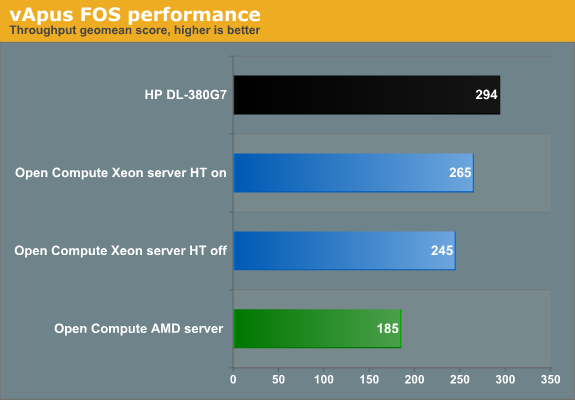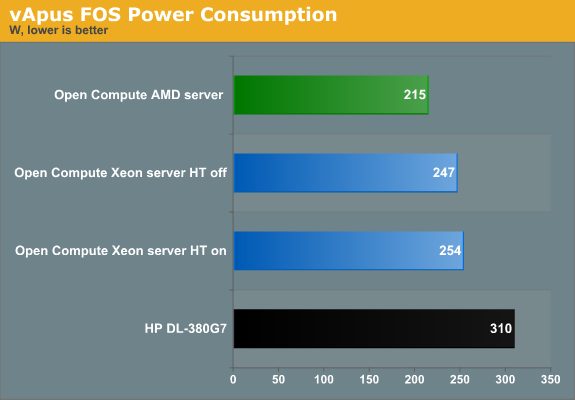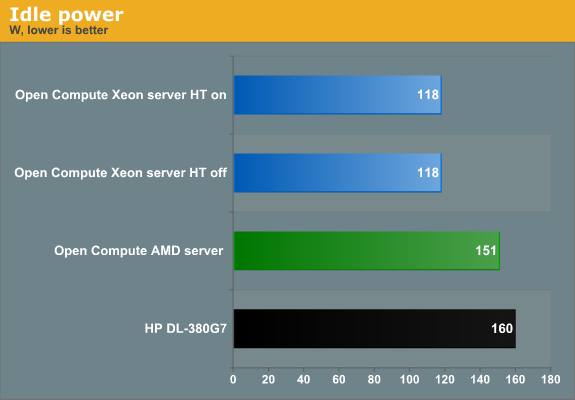Facebook's "Open Compute" Server tested
by Johan De Gelas on November 3, 2011 12:00 AM ESTvApus FOS results
In the first test, we use the vApus FOS test that pushes the servers to 90 - 100% CPU load. This performance test is not really important as these kind of server / application combinations are not supposed to run at these high CPU loads. Also remember that this is not an AMD versus Intel graph. The AMD based Open Compute server is used as a memcached server that typically hogs RAM space but does not stress the CPU; the Intel Open Compute Server is built to be a CPU intensive web application server. Thus, you should not compare them directly.
The real comparison is between the HP DL-380G7 and the Facebook Open Compute Xeon Server, which both use the same platform: the same CPUs, the same amount of RAM, and so on. The big question we want to answer is whether Facebook's server that is built specifically for low power use and cloud applications can offer a better performance/watt ratio than one of the best and most popular "general purpose" servers.

When requiring the highest performance levels, the HP DL380 G7 is about 11% faster than the Open Compute alternative. We suspect that the Open Compute server is configured to prefer certain lower power, lower performance ACPI settings. However, as this server is not meant to be an HPC server, this matters little. A web server or even virtualized server should not be run at 95-100% CPU load anyway. Let us take a look at the corresponding power consumption.

To deliver 11% higher performance, the HP server has to consume about 22% more power. The Open Compute servers deliver a higher performance/watt even at high performance levels. The advantage is small, but again these servers are not meant to operate at 95+ % CPU load.
We also checked the power consumption at idle.

The results are amazing: the Open Compute servers need only 74% of the power of the HP, saving a solid 42W when running ide. Also remember that the HP DL380 is already one of the best servers on the market from power consumption point of view.
Let us see what happens if we go for a real-world scenario.










67 Comments
View All Comments
fpsvash - Thursday, November 3, 2011 - link
In the middle of the paragraph below the image caption, the sentence reads "...and offers better slightly better performance..."Other than that, nice post!
ahmetmy330 - Thursday, December 29, 2016 - link
this is my university work about open servers. Thanks for posthttp://www.h2kjamaica.com/maddenmobilehack/
InternetGeek - Thursday, November 3, 2011 - link
It's interesting that no many players have taken a look at Open Compute.alent1234 - Thursday, November 3, 2011 - link
it's a solution for a specific workload. there are still a lot of workloads that require the traditional model of big database serversunlike your bank, facebook's noSQL is not ACID
FunBunny2 - Saturday, November 5, 2011 - link
Well, yes a voice of reason. OTOH, the Facebook et al folks are convinced that their back to the COBOL era is the future. As if a toy application, albeit pervasive, is "innovation".Sivar - Saturday, November 5, 2011 - link
It's a little difficult to look at a comment about Facebook being a toy application and take it seriously. Yes, Facebook is not directly processing bank transactions on a Tandem, but their site is used to conduct business -- and is even the basis for many businesses, all over the world.Zynga, the company that makes a few annoying games for Facebook, is worth $15 -- more than Electronic Arts.
Nearly every major online publisher, including Anandtech, uses their API for content distribution and often as the entire forum system for discussion of publications.
The founder is the youngest billionaire in history.
Calling theirs a toy application sounds like a Blockbuster customer calling Redbox a toy. It's denial of an obviously successful, large, powerful, innovative company because they don't do things "the old way."
I suspect what matters more is that the business is executing flawlessly, the actual problems with data loss or other non-ACID compliant traditional issues are minimal, and that they are making enough money that Google and Microsoft are feel seriously threatened.
One last thing -- if you really look into what ACID compliance means (and I know you did not specifically mention the acronymn, but replied to someone that did) none of the current major DBMS's are truly ACID compliant. It's too slow. Not Oracle. Not MSSQL. Not Greenplum. Not Teradata. None of them. They may be closer than NoSQL or the like, but then it's all about the right tool for the job, right?
Ceencee - Wednesday, November 9, 2011 - link
This is true but ACID can be over-rated for many workloads. How many pieces of data HAVE to be consistent across the entire cluster to be valid? What about NoSQL with configurable consistency like Cassandra?NoSQL databases provide the holy grail of system growth which is horizontal scaling and this is no small thing for anyone who has worked with a very large RDBMS like ORACLE and implemented RAC to find it doesn't scale all that linearly for most workloads.
ahmetmy330 - Sunday, January 1, 2017 - link
ctually i assume you might have actually stumble upon these dubious <a href="http://www.h2kjamaica.com/bowlingkinghack/"&g... King cheats </a>programs and software packages downloads but are convinced usahmetmy330 - Thursday, January 12, 2017 - link
http://www.onslow.us/8ballpoolhack/I have told you
ac2 - Thursday, November 3, 2011 - link
Wouldn't the presence of the graphics on the HP server account for the 32W idle load savings?